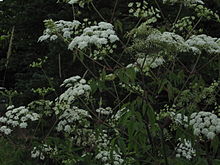- Cicuta maculata
-
Cicuta maculata 
Scientific classification Kingdom: Plantae (unranked): Angiosperms (unranked): Eudicots (unranked): Asterids Order: Apiales Family: Apiaceae Genus: Cicuta Species: C. maculata Binomial name Cicuta maculata
L.Synonyms Cicuta bolanderi
Cicuta curtissii
Cicuta mexicana
Cicuta occidentalis[1]Cicuta maculata is a species of flowering plant in the carrot family known by several common names, including spotted water hemlock, spotted parsley, spotted cowbane, and the suicide root by the Iroquois. It is native to nearly all of North America, from northern Canada to southern Mexico. This is a rhizomatous perennial herb producing a hollow erect stem to a maximum height between 1 and 1.5 meters. The long leaves are made up of several lance-shaped, pointed, serrated leaflets. Each shiny green leaflet is 2 to 10 centimeters long and the entire leaf may be up to 40 centimeters long. The inflorescence of white flowers is similar in appearance to many other species in the carrot family. It is a compound umbel with a many clusters of flowers. The dry tan-brown fruit is a few millimeters long.
Contents
Toxicity
Main article: Cicuta toxicityThe plant is occasionally mistaken for parsnips, due to its clusters of white tuberous roots; this is an often fatal error, as the Cicuta is extremely poisonous. Indeed, spotted water hemlock is considered to be North America's most toxic plant.[2][3] Cicuta is fatal when swallowed, causing violent and painful convulsions. Though a number of people have died from water hemlock poisoning over the centuries, livestock have long been the worst affected (hence the name "cowbane"), causing death in as little as 15 minutes. [4],[5]
The chief poison is cicutoxin, an unsaturated aliphatic alcohol that is most concentrated in the roots. Upon human consumption, nausea, vomiting, and tremors occur within 30-60 minutes, followed by severe cramps, projectile vomiting, and convulsions. There are occasional long-term effects, like retrograde amnesia.[6] Ingestion of water hemlock in any quantity can result in death or permanent neurological damage of the central nervous system.
Similar species
This plant has white flowers in large compound umbels. Therefore, it may be confused with water parsnip, (swamp parsnip, sium suave) and western water hemlock, (Cicuta douglasii). Water parsnip and spotted water hemlock both have cluster of small white flowers shaped like umbrellas, and both have the same habitat near the shore line of lakes, and rivers. Water parsnip has leaves only once compound, and water hemlock has leaves which are three times compound. Spotted water hemlock has a large swelling at the stem base. All Cicuta are highly poisonous.[7] Water parsnip is not poisonous.[8] The water hemlock has bracts at the base of each small flower cluster, not at the base of the main flower head.[9] The Water parsnip has small bracts at the base of flowers and main flower head as well.[10] The Yarrow, (Common Yarrow, Gordaldo, Nosebleed plant, Old Man's Pepper, Sanguinary, Milfoil, Soldier's Woundwort, Thousand-leaf (as its binomial name affirms), Thousand-seal or Achillea millefolium) also has many small white flowers in a cluster. However the yarrow has feathery looking leaves which are pinnately separated into small narrow segments.[11] The cow parsnip (heracleum lanatum, Heracleum maxinium Indian Celery or Pushki, and Heracleum sphondylium, hogweed) is also confused in this group with similar flower groupings. However, the cow parsnip has large, broad leaves, and an unpleasant odour.[12]
External links
References
- ^ GRIN Species Profile
- ^ Schep LJ, Slaughter RJ, Becket G, Beasley DM (April 2009). "Poisoning due to water hemlock". Clin Toxicol (Phila) 47 (4): 270–8. doi:10.1080/15563650902904332. PMID 19514873.
- ^ http://www.ars.usda.gov/Services/docs.htm?docid=9996 "USDA Poisonous Plant Research Products: Water hemlock". Accessed 1/27/07.
- ^ http://cal.vet.upenn.edu/poison/plants/ppwater.htm "Poisonous Plants Slides: Water Hemlock" Accessed 1/27/07.
- ^ USDA.
- ^ http://www.pubmedcentral.nih.gov/pagerender.fcgi?artid=1455113&pageindex=1#page David J. Costanza, M.D., and Vincent W. Hoversten, M.D., "Accidental Ingestion of Water Hemlock." Calif Med. 119: 78-82, Aug. 73.
- ^ "Cicuta maculata.". http://www.em.ca/garden/native/nat_cicuta_maculata.html. Retrieved 2008-08-03.[dead link]
- ^ "Traditional Plant Foods of Canadian Indigenous Peoples By Harriet V Kuhnlein, Nancy J.". Google books. http://books.google.ca/books?id=fPDErXqH8YYC&pg=PA124&lpg=PA124&dq=hemlock++saskatchewan&source=web&ots=wEZs3Qy1Nb&sig=4XiR4NlX_41oreXB54L841HnbIs&hl=en&sa=X&oi=book_result&resnum=10&ct=result#PPA124,M1. Retrieved 2008-08-03.
- ^ "Western Water Hemlock - Agriculture - Government of Saskatchewan". http://www.agriculture.gov.sk.ca/Default.aspx?DN=6896bcb3-d202-43e0-ace9-c4ec72d8835d. Retrieved 2008-08-03.
- ^ "Water Parsnip - Agriculture - Government of Saskatchewan". http://www.agriculture.gov.sk.ca/Default.aspx?DN=e2b0945b-6609-4790-ae82-8fdd9135af26. Retrieved 2008-08-03.
- ^ "Yarrow Achillea millefolium". http://www.em.ca/garden/native/nat_Achillea%20millefolium.html. Retrieved 2008-08-03.
- ^ "Heracleum lanatum". University of Saskatchewan. http://www.usask.ca/agriculture/plantsci/classes/range/heracleum.html. Retrieved 2008-08-03.
Categories:
Wikimedia Foundation. 2010.
